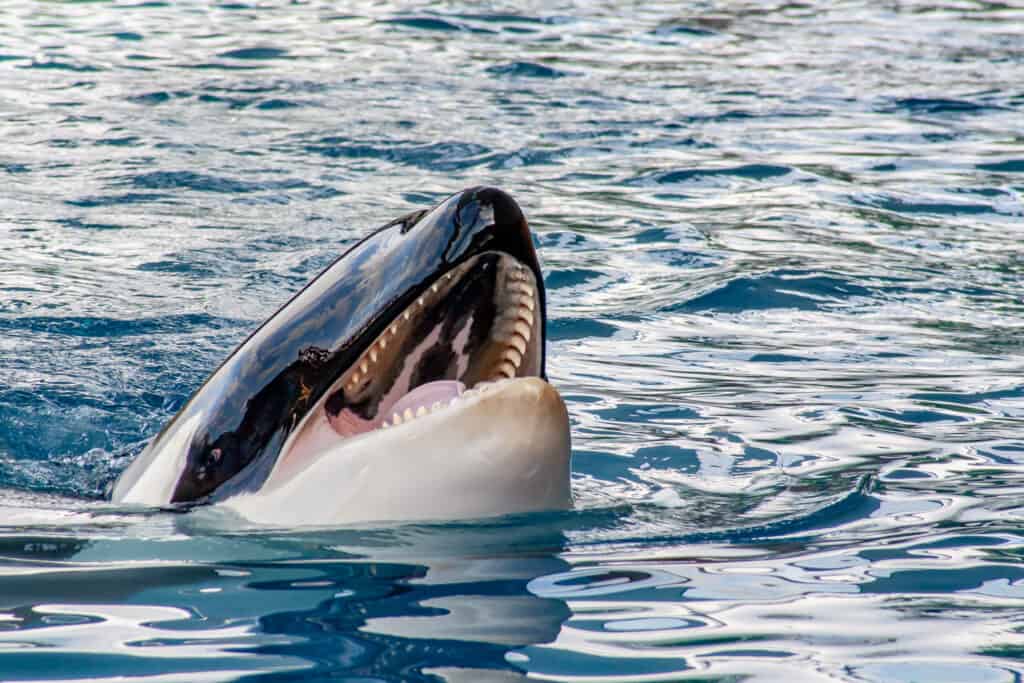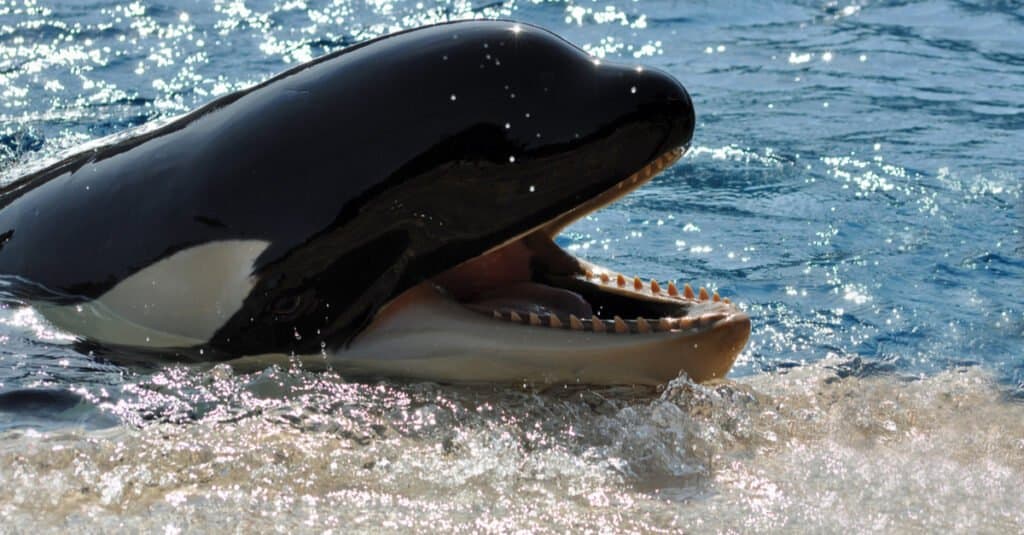
The post Killer Whales Are Such Predators They Even Hunt Moose…Yes, Moose appeared first on A-Z Animals.
Moose (Alces alces) are excellent swimmers. Moose that live along the Pacific coast of Alaska and Canada frequently swim from island to island to forage for food. They can dive as deep as 20 feet searching for aquatic vegetation. Moose on land may have to be wary of grizzly bears and wolves, but there is no safety to be found in the water either. It may sound unbelievable, but pods of orcas (Orcinus orca) hunt and prey on moose.

Orcas, known as killer whales, are at the top of the food chain.
©Guillermo El Oso/Shutterstock.com
How Orcas (Killer Whales) Are Predators of Moose
A YouTube video from BioArk delves into the hunting and killing methods of orcas, specifically their approach to targeting moose. It may sound impossible when you think of a sea mammal hunting a land mammal, but the narrator explains that we have evidence. “Moose carcasses have been found off the coast of Vancouver with lacerations consistent with orca bites.”

Orcas are incredibly intelligent and hunt larger prey, working together in pods.
©BioArk / YouTube – Original
But how does it happen that an ocean dweller can prey on a large herbivore that lives on land? For one thing, moose are excellent swimmers. According to the video, moose can swim five miles an hour, which is faster than Olympic athletes. They also dive deep to look for aquatic vegetation when plants on land become scarce.
Moose may also venture into the water to keep cool in the summer. Unfortunately for moose, when they are out swimming in the open ocean, they are at risk of being hunted by orca pods. Orcas have strong conical-shaped interlocking teeth, which are designed to grasp their prey and tear it into easier-to-swallow chunks.
How Orcas Hunt

Killer whales have conical-shaped, interlocking teeth that they use to grasp their prey.
©Heather Renee/Shutterstock.com
Orcas are incredibly intelligent and work together in groups when they hunt their prey. They are fast and powerful swimmers, reaching speeds of over 30 miles per hour (much faster than a moose at 5 miles per hour). Moose are massive land animals, ranging from 800 to 1,600 pounds, and can grow almost six feet tall. Orcas, however, are even more massive. Male orcas are larger than females and can reach 33 feet in length, weighing about 22,000 pounds.
Orca pods work together to kill prey much larger than themselves. They were given the name “killer whales” when ancient sailors noticed them hunting down and killing large whales. A slow-moving moose, tiredly swimming from island to island, wouldn’t have much of a chance against a pod of determined orcas.
Orcas are intelligent and use strategies when hunting. They surround schools of fish and kill them by slapping them with their tails. When hunting whales, they will surround the tired creature, giving it no way out. They even know how to smother the whale’s blowhole to drown it.

Orcas know how to knock penguins off their icy perches.
©BioArk / YouTube – Original
They have different strategies for hunting penguins and seals. Although penguins and seals have learned to hop on ice sheets to avoid predators, orcas know a way around this. The pod will swim together under an ice sheet, creating such a large wave that the animal falls off into the water. What’s even more fascinating is that sometimes the orcas will toss the fallen seal back onto another ice sheet, and then knock them off again. We don’t know — are they practicing their technique, or simply having fun?
Do Orcas Intentionally Hunt Moose or Take Advantage of Chance Encounters?
An orca’s main diet consists of fish, squid, seals, and the occasional whale. It’s only in certain locations where moose and orca habitats collide. When a pod of orcas spots a moose swimming in the open ocean, they may see the moose as yet another food source. But it’s only in these rare places where their habitats may overlap that an orca pod would even encounter a moose.
Which Animals Prey on Moose in the Wild?
It’s the rare moose that has to fear attacks from orcas. Generally, moose are in danger of predators such as grizzly bears, black bears, and wolves. Moose have long and powerful legs, which they use for kicking and stomping to defend themselves. They will kick predators in the head with their hooves or spar with their antlers.
The smaller calves are in the most danger from predators, but are under the protection of their mothers, who will kick any predator who comes near their calves. Once a moose is fully grown, their risk of being eaten by a bear or wolf goes down. Unfortunately, these defensive methods, like kicking and stomping, are useless in the water against killer whales.
Conservation Efforts: Orcas and Moose
Moose are not endangered and are a species of least concern on the IUCN Red List. However, they do face threats from hunting and habitat loss. They are also suffering from warmer winters due to climate change. Moose are adapted to the cold weather, and when it warms up, they can overheat or suffer from disease and tick infestations.
The IUCN Red List classifies the population status of killer whales as Data Deficient due to a lack of data. However, NOAA Fisheries lists the southern resident killer whales as at-risk with a declining population.
The post Killer Whales Are Such Predators They Even Hunt Moose…Yes, Moose appeared first on A-Z Animals.
June 16, 2025 at 05:02PMJennifer Geer
.jpeg)
.jpeg)

0 Comments